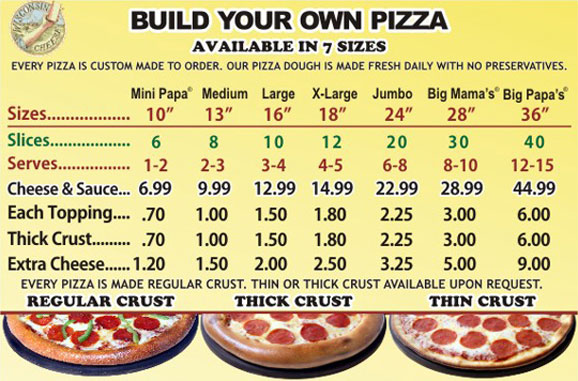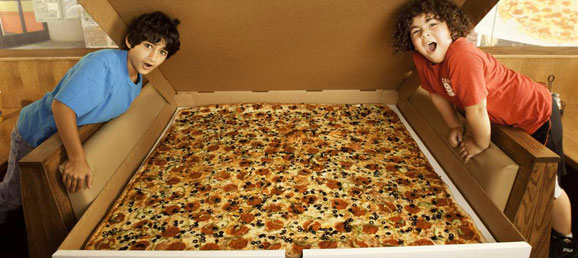- Do four cheese Big Papa’s or one cheese Giant Sicilian give you more pizza for your money?
- What is a guess that is too low?
- What is a guess that is too high?
- What is your best guess?
- What factors may affect the accuracy of our answer?
- What information do we need to figure it out?
The image below has all of the information students will need to find the unit cost of the Big Papa’s pizza. As you may expect, some students will use the 36″ measurement as the pizza’s radius instead of the diameter. If that happens, then they will get roughly 4000 sq inches of pizza, which is more than the Giant Sicilian and hopefully enough of a red light that they realize something went wrong.

The Giant Sicilian’s is a 54″ square pizza. There is more detail about it in this lesson.
It may be worth discussing that while the unit rate of the Big Papa pizza does not change regardless of the number of pizzas ordered, by the time you reach 3 pizzas, you already have more pizza for the money.
I am also making the assumption that all parts of the pizza are the same so I am not taking into consideration how much is crust versus how much has sauce, cheese, and toppings.
- CCSS 3.MD.5 Recognize area as an attribute of plane figures and understand concepts of area measurement.
- CCSS 3.MD.6 Measure areas by counting unit squares (square cm, square m, square in, square ft, and improvised units).
- CCSS 3.MD.7 Relate area to the operations of multiplication and addition.
- CCSS 4.MD.3 Apply the area and perimeter formulas for rectangles in real world and mathematical problems. For example, find the width of a rectangular room given the area of the flooring and the length, by viewing the area formula as a multiplication equation with an unknown factor.
- CCSS 6.RP.1 – Understand the concept of a ratio and use ratio language to describe a ratio relationship between two quantities. For example, “The ratio of wings to beaks in the bird house at the zoo was 2:1, because for every 2 wings there was 1 beak.” “For every vote candidate A received, candidate C received nearly three votes.”
- CCSS 6.RP.2 – Understand the concept of a unit rate a/b associated with a ratio a:b with b ≠ 0, and use rate language in the context of a ratio relationship. For example, “This recipe has a ratio of 3 cups of flour to 4 cups of sugar, so there is 3/4 cup of flour for each cup of sugar.” “We paid $75 for 15 hamburgers, which is a rate of $5 per hamburger.”
- CCSS 6.RP.3 – Use ratio and rate reasoning to solve real-world and mathematical problems, e.g., by reasoning about tables of equivalent ratios, tape diagrams, double number line diagrams, or equations.
- CCSS 7.G.4 Know the formulas for the area and circumference of a circle and use them to solve problems; give an informal derivation of the relationship between the circumference and area of a circle.



Maybe I’m missing it, but I can’t find the price of the Giant Sicilian anywhere. I even looked on the restaurant website, and it is not listed as an option.
Have you watched the video? The video says the price: $199.
Just a heads up, if the students do some research on the website it shows that the price of the pizza is now $299 (http://www.bigmamaspizza.com/)
Ah. Thanks for the update Amy.
I tried to download and downloaded this page only. I went to download lesson files and nothing happened. Are there any other actual lesson plans to go with this topic for more depth of knowledge?
Hi Michelle. Downloading the lesson files will give you all the images/videos/handouts depending on what is available. Downloading the PDF will just give you a downloadable version of what’s on the page.
I love this as an extension for the rates unit that we are doing. I just had a hard time figuring out how to have the kids make an estimate. Also, when they asked, I gave them the formula for finding circumference instead of the area of a circle. Argh!!!!!
Yeah, these lessons are easier to implement in theory than in practice. If you’d like more support with thinking them through, check out my online workshop here: https://robertkaplinsky.com/eps/
Hi! I am still learning about Problem Based Math Tasks, and would love to do this lesson with my students since we just did the Giant Sicilian Lesson the other day. However, I want to make sure I provide them with the correct information. Do you mind sharing the answers so I can make sure I don’t misguide them.